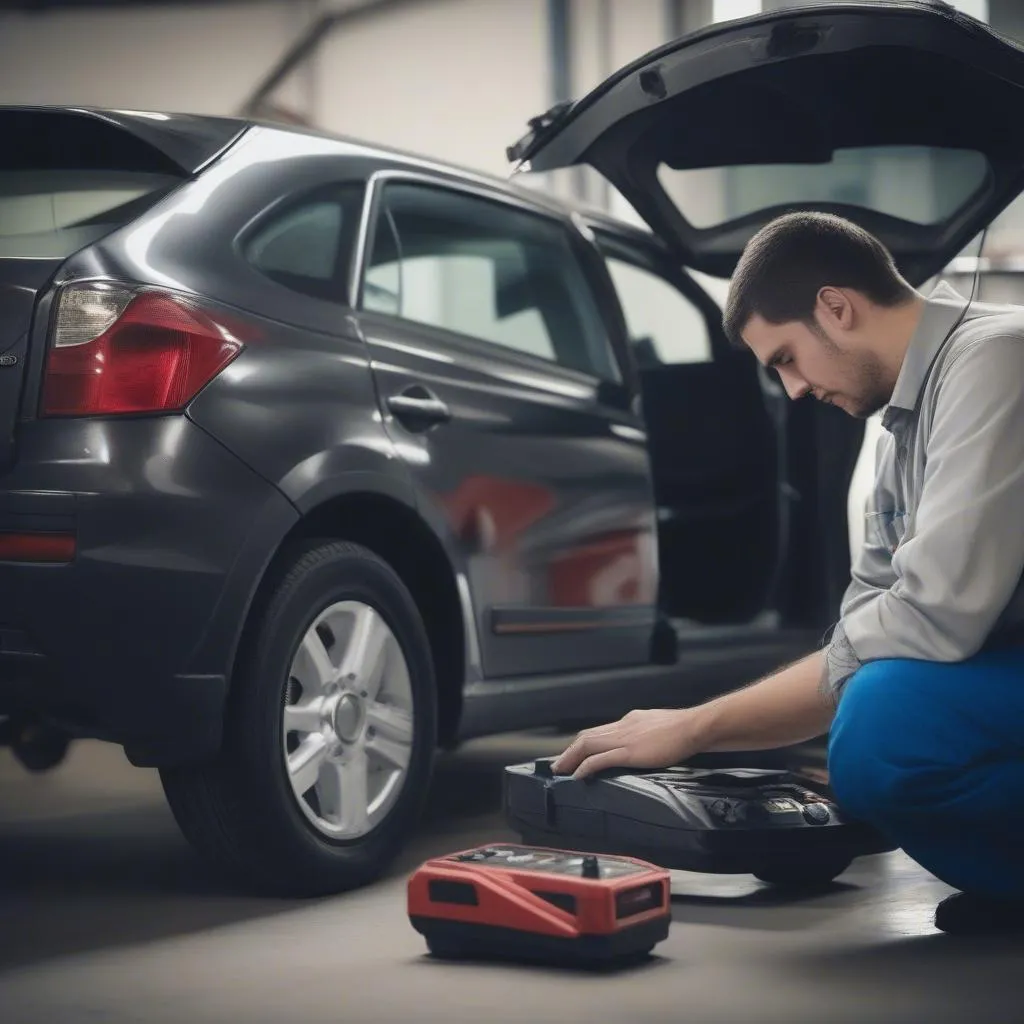The brake system warning light on your dashboard is a crucial safety feature. When illuminated, it signals a potential issue with your vehicle’s braking system that requires immediate attention. Ignoring this warning could lead to reduced braking performance or even complete brake failure, putting you and others on the road at risk. This comprehensive guide will delve into the common reasons behind a lit brake warning light, ranging from simple fixes to more complex issues requiring professional attention.
Understanding the Brake Warning Light
 Brake warning light on car dashboard
Brake warning light on car dashboard
The brake warning light is typically red and often displays an exclamation mark within a circle, resembling a stylized brake drum. In some vehicle models, the word “BRAKE” may illuminate instead. This light serves several purposes:
- Low Brake Fluid Level: This is the most common reason for the warning light to activate. A leak in the brake lines or worn-out brake pads can cause the fluid level to drop.
- Engaged Parking Brake: If you start driving with the parking brake partially or fully engaged, the warning light will illuminate as a reminder to release it.
- Brake System Malfunction: A more serious issue, such as a faulty ABS (Anti-lock Braking System) module or a problem with the brake pressure sensor, can also trigger the warning light.
Common Causes of Brake Warning Light Activation
1. Low Brake Fluid
Brake fluid is the lifeblood of your braking system. It transmits the force applied to the brake pedal to the calipers, which then press the brake pads against the rotors to slow down or stop your vehicle.
How to Check: Locate the brake fluid reservoir under the hood. It’s usually a translucent plastic container with a “MIN” and “MAX” marking. If the fluid level is below the “MIN” line, it needs to be topped up.
What to Do: Carefully add the correct type of brake fluid recommended in your owner’s manual. If you notice a consistent need to top up the fluid, it indicates a leak that requires immediate professional attention.
2. Worn Brake Pads
Brake pads are designed to wear down over time. Most modern vehicles have wear indicators built into the brake pads. These indicators make a high-pitched squealing sound when the pads become too thin, alerting you to their replacement need.
What to Do: If you hear squealing or grinding noises when braking or notice the brake pedal feeling spongy, it’s crucial to have your brake pads inspected and replaced if necessary by a qualified mechanic.
3. Faulty ABS System
The Anti-lock Braking System (ABS) is a crucial safety feature that prevents wheel lockup during hard braking, maintaining steering control and preventing skidding. A malfunctioning ABS module or sensor can trigger the brake warning light.
What to Do: If the ABS light also illuminates alongside the brake warning light, it typically indicates an issue with the ABS system. Diagnosing ABS problems requires specialized equipment, so it’s best to consult a qualified mechanic.
When to Seek Immediate Assistance
“Ignoring a lit brake warning light is akin to playing Russian roulette with your safety,” cautions John Miller, a seasoned automotive engineer with over 20 years of experience in brake system diagnostics. “Even seemingly minor issues can escalate quickly, leading to potentially dangerous situations.”
While some causes, such as low brake fluid, can be addressed with basic maintenance, others necessitate the expertise of trained professionals. Here are situations warranting immediate professional assistance:
- Illuminated Brake Warning Light Despite Sufficient Brake Fluid: This suggests a more complex issue within the braking system, such as a faulty sensor, master cylinder problem, or hydraulic line leak.
- Spongy or Soft Brake Pedal: A soft brake pedal indicates air in the brake lines, which significantly compromises braking performance.
- Grinding Noise When Braking: This usually signals worn-out brake pads, requiring immediate replacement to avoid damaging the brake rotors.
- Vehicle Pulling to One Side While Braking: This could point towards uneven brake pad wear, a stuck caliper, or a problem with the hydraulic system.
Conclusion
The brake warning light is a crucial safety indicator that should never be ignored. While some causes might be straightforward, such as low brake fluid or engaged parking brake, others can signal serious underlying problems within the braking system. Promptly addressing any illuminated warning light related to your brakes ensures your safety and that of your passengers and fellow drivers on the road. When in doubt, always consult with a qualified mechanic for a thorough inspection and diagnosis.

